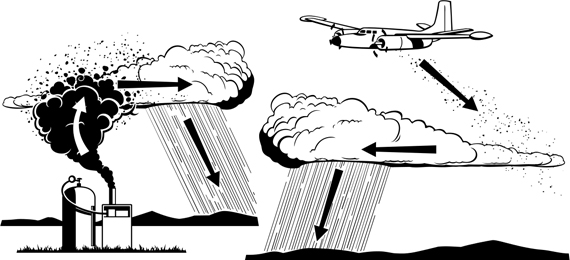
Clouds are made of water droplets. The molecules huddle together and form larger and heavier droplets. When these droplets get too heavy to stay suspended in the cloud, they fall to the ground as precipitation. Many countries do this artificially with a method called cloud seeding. In this article, we will discuss what is cloud seeding and types of cloud seeding.
What is Cloud Seeding?
Clouding seeding, also known as man-made enhancement, artificial weather modification, and rainmaking is a process that involves changing the structure of clouds in order to increase the chance of precipitation. In the process of cloud seeding, small ice-like particles are added to the clouds. Silver iodide, potassium iodide, and dry ice are few such particles that act as additional condensation nuclei that facilitate the formation of raindrops or snowflakes. In the absence of the condensation nuclei, rainfall cannot form and eventually precipitation does not occur. Cloud seeding adds artificial condensation nuclei and this draws water vapour within the cloud and latches the moisture. These water droplets group together forming a droplet that is large enough to fall as rain.
Types of cloud seeding: Static, Dynamic, Hygroscopic are the three types of cloud seeding methods.
The Silver Iodide Is Toxic to Aquatic Life.
- A. True
- B. False
This process of rainmaking has its roots in 1946 during the world’s first artificial snowfall from its base. The company says that American scientists Vincent Schaefer and Bernard Vonnegu climbed into a Fairchild plane and seeded the floating cloud with dry ice. In the 1960s, in a project called “Stormfury” was taken up to try and weaken cyclones. Later, this method was improved and silver iodide was used instead in order to induce snow.
Since the 1990s, UAE has been using the technology. Recently used it in 2015 Research Program for Rain Enhancement Science.
The US has also been using the technology In the mountainous and dry areas since the 1950s.
Later, global scientific research and development have made the method of cloud seeding a popular one.
At least 56 countries have active cloud seeding programs including India, the United Arab Emirates, the United States, China, and the United Kingdom.
Usually, cloud seeding involves two ways of adding particles to clouds:
- Using large cannon that shoot particles into the sky.
- Using airplanes, rockets, or from other dispersion devices that drop the particles from above.
Uses of Cloud Seeding:
- To increase snowfall in Skiing places
- In order to increase the water runoff for electricity, Hydroelectric companies use it too.
- In order to turn fog into precipitation for improved visibility around airport areas.
- Places like China, Russia, and Thailand, have used cloud seeding to put our forest fires.
Risks of Cloud Seeding
- Even though Cloud seeding can create a 10-15% increase in rainfall, many suggest that there are other risks involved in public safety and environment.
- The silver iodide used is said to be toxic to aquatic life, therefore the precipitation from seeded clouds can damage the environment. In replacement of this, scientists have planned to use calcium iodide and the use of negatively charged ions in replacement to ice-like crystals.
- In 1972, a sudden flash flood in Rapid City, South Dakota made people suspect the nearby cloud seeding operation. However, there is no tangible evidence for it. According to the Clean Water Act, Silver Iodide is considered one of the hazardous substances and toxic pollutants, but however, scientists say that substance used in this is of low concentration.
This idea could help areas with little rainfall and the risk of drought. But this process can sometimes be worked in reverse too. China says that during the Beijing Olympics in 2008, they used Cloud seeding to actually stop the rain.